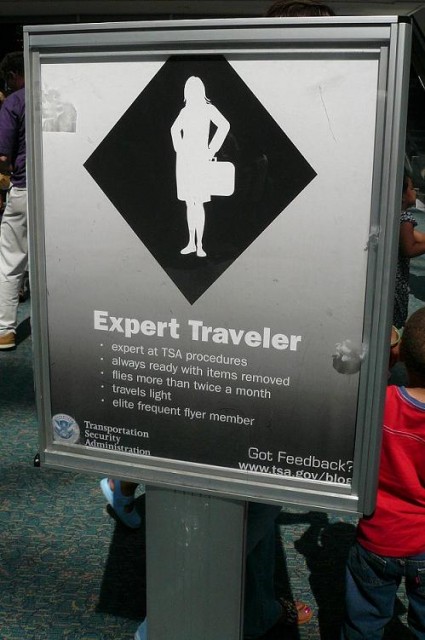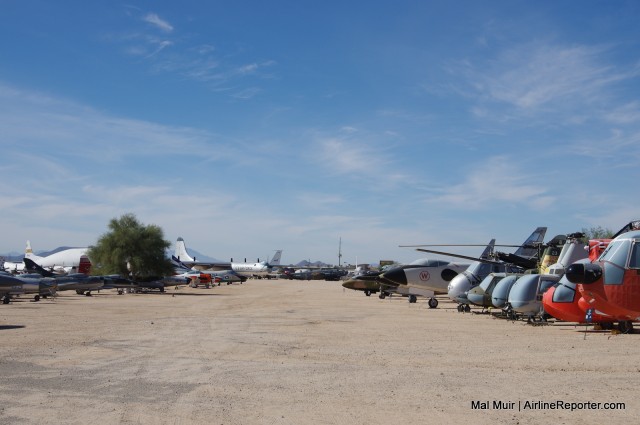
A look down one of the “streets” in the outdoor portion of the Pima Air & Space Museum
Tucson, Arizona is home to the University of Arizona and also Raytheon Missile systems. Those two companies, along with the US Air Force, form the largest three employers in the city. However, Tucson is also home to a unique AvGeek attraction, one that will astound any true aviation fan.
The Pima Air & Space Museum is located about a five-minute drive from Tucson airport and on the boundaries of Davis Montham Air Force Base. The museum is the largest privately funded aviation museum in the world, yes’¦ the world.
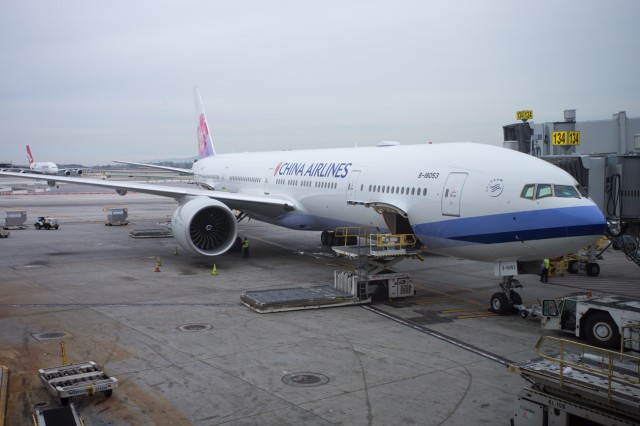
China Airlines’ Boeing 777-300ER – Photo: Jeremy Dwyer-Lindgren
When China Airlines unveiled its new Boeing 777-300ER back in early October of this year, it was clear that this airplane was something special. Photos and videos of the new interioroutfitted with a snazzy new business cabin, homages to Taiwanese culture, and a small libraryquickly made the internet rounds, establishing this plane as the hot new item in the air.
Having seen it myself in Seattle, I knew it had to try it once it was released into the wild. Fast forward two months to last Monday (December 1), when I found myself, ticket in hand, ready to board China Airlines flight 5, service from Los Angeles LAX to Taipei. AirlineReporter/NYCAviation were invited by the airline to sample the carrier’s promising-looking new business class. The formal adventure began in the lounge at Los Angeles International Airport.
China Airlines (CAL), does not have one of its own at the airport, and thus utilizes Korean’s SkyTeam lounge instead. As far as lounges go, this one runs above average, largely thanks to its new-ness and an exterior deck overlooking the main hall. I helped myself to a few finger sandwiches and a beverage while checking email on the free WiFi. Boarding began on time at gate 134. Holding a ticket for the carrier’s premium business class, I boarded quickly via a dedicated jet-way connected to the L1 door.
Those with business tickets are split between two cabins, and today’s seat22Awas in the rear section nestled behind the L2 door. Both cabins are set up in a reverse herringbone style in a 1-2-1 configuration. As boarding continued, cabin crew offered a selection of non-alcoholic pre-flight drinks and hot towels. Bags and personal items slipped easily into overhead bins or into one of three built-in storage areas in the seat. The giant Boeing 777-300ER easily lifted off runway 25R and turned northwest to head up the California coast for the scheduled 14-hour flight to Taipei’s Taoyuan International Airport.
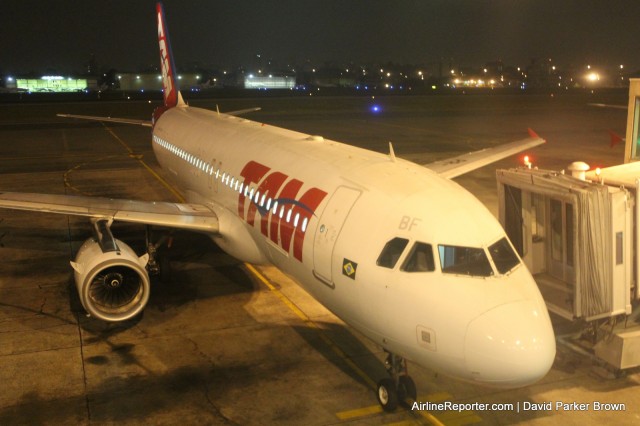
Our TAM Airbus A320 at Congonhas-São Paulo Airport
In Part 1 of my trip I talked about the process of getting to Brazil and went over the first day of the media trip. I had just spent my one and only night in Brazil, and was in the hotel lobby at 4:30am local time to start day two. Bring it!
At this point, I was definitely feeling the lack of sleep. I had used all the coffee packets in my hotel room. The first thing of the day was for us to head to Sao Paulo’s secondary airport, Congonhas-São Paulo Airport (CGH), which was only 15 minutes away from the hotel. Our destination? Leite Lopes Airport (RAO), then about an hour’s drive to TAM’s Museum and Maintenance facility (MRO).
This was exciting for me for a number of reasons. First off, just being able to see the Museum and MRO, of course. But also, this was going to be the first time that I had ever flown on a non-US domestic flight. It seemed weird to me and thinking about it at 5am, I thought that I might had missed a memory, but nope, this was the first time and something to check off the ol’ AvGeek to-do list.
CGH is a small airport. This made it easy to get checked in and to our gate. Originally the flight was to depart from a remote gate, meaning boarding from the tarmac (yay), but at the last minute, it was changed to a real gate (boo). TAM originally had us three journalists (me, Jason Rabinowitz and Cynthia Drescher) seated together. No good. Not that we don’t like each other (we actually get along quite lovely), however we each wanted out own window seats. Luckily the flight was not that booked and we made it happen.
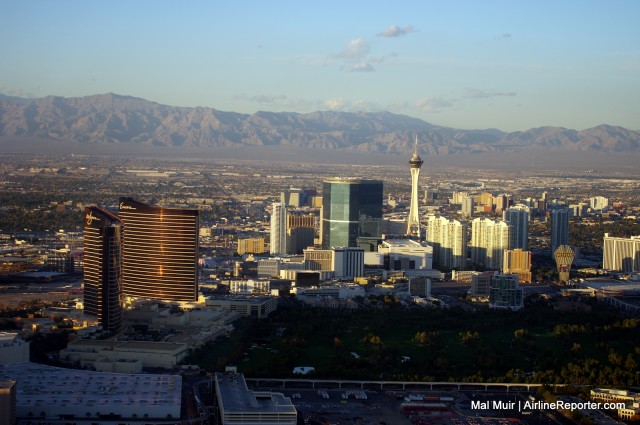
The northern end of the Las Vegas Strip, with the Wynn, Encore, & Stratosphere dominating the skyline
A great way to get a different perspective of a place is to take a flight over it. Heading to somewhere you haven’t been before, well why wouldn’t you take a flightseeing trip to get that different perspective? As part of my honeymoon with my wife Heidi after our AvGeek wedding, we wanted to have a few new experiences each on this trip. One of the things that I like to do is take a helicopter ride over cities.
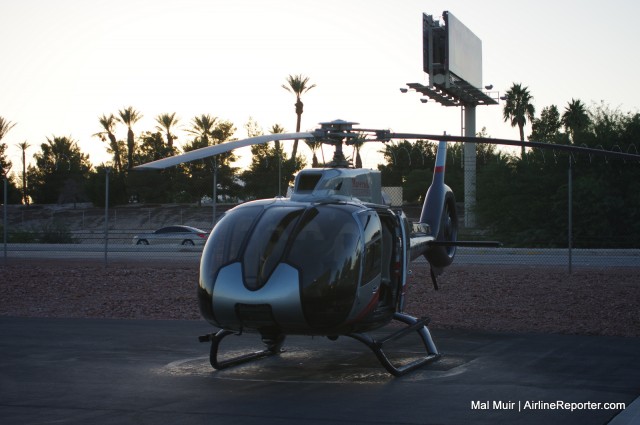
A Maverick Helicopters Eurocopter EC-130 Ecostar on the flightline at Las Vegas Airport
When we decided to visit Las Vegas, I really wanted Heidi to get that experience of seeing the city by hovering above (since this was her first trip to the city). This would also be not only her first visit to Vegas, but also her first helicopter flight. How could she marry an AvGeek and never have flown in a helicopter before? It was time to change that.
I was recently invited to sit down with a local news outlet to discuss TSA’s Pre ✓™ program from the perspective of a frequent flyer who hadn’t signed up, and questions its utility as the program stands today. To be clear, I do not see the program as a threat to security. Instead, the program’s benefits simply aren’t compelling enough for me to part with $85 and take the time to be interviewed and fingerprinted.
$85 isn’t unreasonable, and there is even an interview site here in my Kansas City suburb. The idea of fingerprinting and background checks don’t bother me either since I’ve been through both as a basis for employment.
Instead, the “gotcha” for me is the fact that while having never signed up for TSA Pre✓™ I have experienced it first-hand many, many times, and I’m just not convinced on its utility to me as a semi-frequent traveler. But why? It comes down to what I like to call the “TSA Pre✓™ dilemma.”





